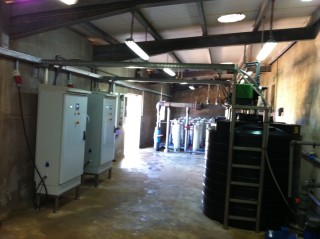| World shrimp farming has grown info a multibillion-dollars giant, creating hundreds of thousands of jobs and much-needed foreign exchange in many countries.
But today the industry is plagued with management, disease and water quality problems which have become the major obstacles to the future of shrimp farming. Hundreds of researchers in a dozen countries and thousands of shrimp farmers in all the shrimp farming countries tinker with new techniques, designs and ideas to improve production.
After months of hard work the Envirolyte Industries International Ltd. along with its trusted partners is proud to announce the successful introduction of Envirolyte machines and activated aqueous solutions, generated by these machines, to the shrimp production industry.
| ELA-1000SW unit at shrimp farm in Madagascar |
The benefits of this new technique are as follows:
- better survival rate at all phases of shrimp farming (hatcheries etc.): from 20-30% up to 60-100%;
- Total abolition of the use of antibiotics;
- better quality of the water, control of Ph of the water and algae growth;
- better yield: from 2-3 tons per pond up to 5-7 tons;
- shorter growth cycle: from 120-160 days to 70 days;
- extra yield per year due to the shorter growth cycle;
- better feed conversion rate;
- effective control of viral and bacterial diseases in the growout phase of shrimp farming;
- shrimps with healthy look and even in sizes as a result of all above listed improvements;
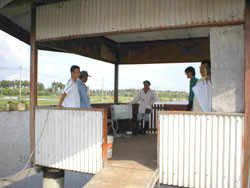 | 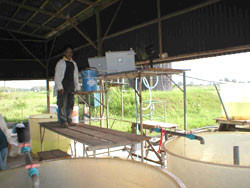 | 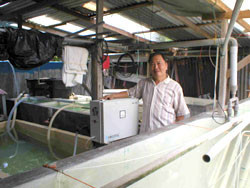 | 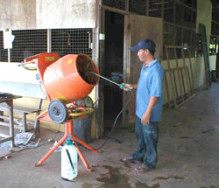 |
The introduction of Envirolyte units and activated solutions to the Shrimp industry definitely marks a break-trough in shrimp production. With the new technique when all phases of shrimp growing become more reliable - and they will - the production of farm-raised shrimp will take another leap forward.
Diseases represent the biggest obstacle to the future of shrimp farming. Farms and hatcheries have few defences against rampaging protozoa, fungi and bacteria, but it's viral diseases that pose the greatest threat. Disinfecting of the water with anolyte at the time when it is stored in the pond and daily disinfecting of the freshly added water is an effective way to solve the problem of the diseases.
Daily disinfecting of hatchery water is a part of an effort to execute an ecosystem approach which eventually pays off with stronger post larvae due to its close approximation of natural conditions and the absents of therapeutics.
Treatment of the prawn feed with anolyte offers several advantages: better feed conversion, faster growth, lower mortalities, and improved water quality.
After anolyte treatment feed becomes moist as well and mechanical feeder can distribute it evenly and efficiently. Wind does not restrict feeding to only one side of the pond any more.
New Shrimp rearing technique in publications.
For instruction details or applications please send Your enquiry ![]()

